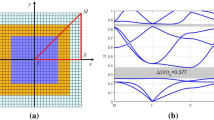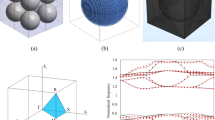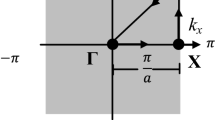Abstract
Phononic band gap crystals are made of periodic inclusions embedded in a base material, which can forbid the propagation of elastic and acoustic waves within certain range of frequencies. In the past two decades, the systematic design of phononic band gap crystals has attracted increasing attention due to their wide practical applications such as sound insulation, waveguides, or acoustic wave filtering. This paper proposes a new topology optimization algorithm based on bi-directional evolutionary structural optimization (BESO) method and finite element analysis for the design of phononic band gap crystals. The study on the maximizing gap size between two adjacent bands has been systematically conducted for out-of-plane waves, in-plane waves and the coupled in-plane and out-of-plane waves. Numerical results demonstrate that the proposed optimization algorithm is effective and efficient for the design of phononic band gap crystals and various topological patterns of optimized phononic structures are presented. Several new patterns for phononic band gap crystals have been successfully obtained.















Similar content being viewed by others
References
Bendsoe MP, Sigmund O (2003) Topology optimization: theory, methods and applications. Springer Science & Business Media, Berlin
Bilal OR, Hussein MI (2011) Optimization of phononic crystals for the simultaneous attenuation of out-of-plane and in-plane waves. In: ASME 2011 International Mechanical Engineering Congress and Exposition, Denver, Colorado, USA, 2011. ASME, Denver, pp 969–972
Bilal OR, Hussein MI (2012) Topologically evolved phononic material: breaking the world record in band gap size. In: SPIE OPTO, 2012. International Society for Optics and Photonics, Bellingham, pp 826911–826917
Dong HW, Su XX, Wang YS, Zhang C (2014) Topological optimization of two-dimensional phononic crystals based on the finite element method and genetic algorithm. Struct Multidisc Optim 50:593–604
Du J, Olhoff N (2007) Topological design of freely vibrating continuum structures for maximum values of simple and multiple eigenfrequencies and frequency gaps. Struct Multidisc Optim 34:91–110
Gazonas GA, Weile DS, Wildman R, Mohan A (2006) Genetic algorithm optimization of phononic bandgap structures. Int J Solids Struct 43:5851–5866
Huang X, Xie YM (2007) Convergent and mesh-independent solutions for the bi-directional evolutionary structural optimization method. Finite Elem Anal Des 43:1039–1049
Huang X, Xie YM (2009) Bi-directional evolutionary topology optimization of continuum structures with one or multiple materials. Comput Mech 43:393–401
Huang X, Xie YM (2010) Evolutionary topology optimization of continuum structures: methods and applications. John Wiley & Sons, Chichester
Huang X, Zuo Z, Xie YM (2010) Evolutionary topological optimization of vibrating continuum structures for natural frequencies. Comput Struct 88:357–364
Huang X, Radman A, Xie YM (2011) Topological design of microstructures of cellular materials for maximum bulk or shear modulus. Comput Mater Sci 50:1861–1870
Huang X, Xie YM, Jia B, Li Q, Zhou S (2012) Evolutionary topology optimization of periodic composites for extremal magnetic permeability and electrical permittivity. Struct Multidisc Optim 46:385–398
Huang X, Zhou S, Sun G, Li G, Xie YM (2015) Topology optimization for microstructures of viscoelastic composite materials. Comput Methods Appl Mech Eng 283:503–516
Hussein MI, Hamza K, Hulbert GM, Scott RA, Saitou K (2005) Multiobjective evolutionary optimization of periodic layered materials for desired wave dispersion characteristics. Struct Multidisc Optim 31:60–75
Hussein MI, Hamza K, Hulbert GM, Saitou K (2007) Optimal synthesis of 2D phononic crystals for broadband frequency isolation. Waves Random Complex Media 17:491–510
Jensen JS, Pedersen NL (2006) On maximal eigenfrequency separation in two-material structures: the 1D and 2D scalar cases. J Sound Vib 289:967–986
Kittel C, McEuen P, McEuen P (1976) Introduction to solid state physics, vol 8. Wiley, New York
Kushwaha MS (1996) Classical band structure of periodic elastic composites. Int J Mod Phys B 10:977–1094
Kushwaha MS, Halevi P, Dobrzynski L, Djafari-Rouhani B (1993) Acoustic band structure of periodic elastic composites. Phys Rev Lett 71:2022–2025
Kushwaha MS, Halevi P, Martínez G, Dobrzynski L, Djafari-Rouhani B (1994) Theory of acoustic band structure of periodic elastic composites. Phys Rev B 49:2313–2322
Liu Y-H, Chang CC, Chern R-L, Chang CC (2007) Phononic band gaps of elastic periodic structures: a homogenization theory study. Phys Rev B 75:054104
Liu Y, Su JY, Xu YL, Zhang XC (2009) The influence of pore shapes on the band structures in phononic crystals with periodic distributed void pores. Ultrasonics 49:276–280
Liu Z, Wu B, He C (2014) Band-gap optimization of two-dimensional phononic crystals based on genetic algorithm and FPWE. Waves Random Complex Media 24:286–305
Lu MH, Feng L, Chen YF (2009) Phononic crystals and acoustic metamaterials. Mater Today 12:34–42
Men H, Nguyen NC, Freund RM, Parrilo PA, Peraire JJ (2010) Bandgap optimization of two-dimensional photonic crystals using semidefinite programming and subspace methods. Comput Phys 229(10):3706–3725
Pennec Y, Vasseur JO, Djafari-Rouhani B, Dobrzyński L, Deymier PA (2010) Two-dimensional phononic crystals: examples and applications. Surf Sci Rep 65:229–291
Querin OM, Young V, Steven GP, Xie YM (2000) Computational efficiency and validation of bi-directional evolutionary structural optimisation. Comput Methods Appl Mech Eng 189:559–573
Rupp CJ, Evgrafov A, Maute K, Dunn ML (2007) Design of phononic materials/structures for surface wave devices using topology optimization. Struct Multidisc Optim 34:111–121
Sethian JA, Wiegmann A (2000) Structural boundary design via level set and immersed interface methods. J Comput Phys 163:489–528
Seyranian AP, Lund E, Olhoff N (1994) Multiple eigenvalues in structural optimization problems. Struct Optim 8:207–227
Sigalas M, Economou E (1992) Elastic and acoustic wave band structure. J Sound Vib 158:377–382
Sigalas M, Economou EN (1993) Band structure of elastic waves in two dimensional systems. Solid State Commun 86:141–143
Sigmund O, Hougaard K (2008) Geometric properties of optimal photonic crystals. Phys Rev Lett 100:153904
Sigmund O, Jensen J (2003) Systematic design of phononic band-gap materials and structures by topology optimization. Philos Trans R Soc London, Ser A 361:1001–1019
Sigmund O, Petersson J (1998) Numerical instabilities in topology optimization: a survey on procedures dealing with checkerboards, mesh-dependencies and local minima. Struct Optim 16:68–75
Vasseur J, Djafari-Rouhani B, Dobrzynski L, Kushwaha M, Halevi P (1994) Complete acoustic band gaps in periodic fibre reinforced composite materials: the carbon/epoxy composite and some metallic systems. J Phys Condens Matter 6:8759
Wang MY, Wang X, Guo D (2003) A level set method for structural topology optimization. Comput Methods Appl Mech Eng 192:227–246
Xie YM, Steven GP (1993) A simple evolutionary procedure for structural optimization. Comput Struct 49:885–896
Xie YM, Steven GP (1997) Basic evolutionary structural optimization. Springer, London
Yang X, Xie YM, Steven G, Querin O (1999) Bidirectional evolutionary method for stiffness optimization. AIAA J 37:1483–1488
Acknowledgments
The second author is the recipient of an Australian Research Council Future Fellowship (FT130101094).
Author information
Authors and Affiliations
Corresponding author
Appendix I
Appendix I
Element mass matrix, M, and element stiffness matrix, K, are calculated by the following equations. For out-of-plane waves,
where
For in-plane waves:
where
where Ω denotes the area of an element. N is the shape function matrix of an element corresponding to out of plane waves or in plane waves. In our numerical examples, linear 4-node elements are used and the shape function matrix can be expressed by:
-
For out-of-plane waves:
$$ \mathbf{N}=\left[\begin{array}{cccc}\hfill {N}_1\hfill & \hfill {N}_2\hfill & \hfill {N}_3\hfill & \hfill {N}_4\hfill \end{array}\right] $$ -
For in-plane waves:
$$ \mathbf{N}=\left[\begin{array}{c}\hfill \begin{array}{cccc}\hfill {N}_1\hfill & \hfill 0\hfill & \hfill {N}_2\hfill & \hfill \begin{array}{cc}\hfill 0\hfill & \hfill \begin{array}{cccc}\hfill {N}_3\hfill & \hfill 0\hfill & \hfill {N}_4\hfill & \hfill 0\hfill \end{array}\hfill \end{array}\hfill \end{array}\hfill \\ {}\hfill \begin{array}{cccc}\hfill 0\hfill & \hfill {N}_1\hfill & \hfill 0\hfill & \hfill \begin{array}{cc}\hfill \begin{array}{cccc}\hfill {N}_2\hfill & \hfill 0\hfill & \hfill {N}_3\hfill & \hfill 0\hfill \end{array}\hfill & \hfill {N}_4\hfill \end{array}\hfill \end{array}\hfill \end{array}\right] $$
The differential element mass matrix and element stiffness matrix with respect to design variable, x e, are:
-
For out-of-plane waves:
$$ \frac{\partial {\mathbf{M}}_e^{out}}{\partial {x}_e}=\left({\rho}_1-{\rho}_2\right){\displaystyle {\int}_{\varOmega }{\mathbf{N}}^T\mathbf{N}d\varOmega } $$(39)$$ \frac{\partial {\mathbf{K}}_e^{out}}{\partial {x}_e}=\left({\mu}_1-{\mu}_2\right){\displaystyle \sum_{m=1}^4{\mathbf{K}}_m^{out}} $$(40) -
For in-plane waves:
$$ \frac{\partial {\mathbf{M}}_e^{in}}{\partial {x}_e}=\left({\rho}_1-{\rho}_2\right){\displaystyle {\int}_{\varOmega }{\mathbf{N}}^T\mathbf{N}d\varOmega } $$(41)$$ \frac{\partial {\mathbf{K}}_e^{in}}{\partial {x}_e}={\displaystyle \sum_{m=1}^6\frac{\partial {\mathbf{K}}_m^{in}}{\partial {x}_e}} $$(42)
\( \frac{\partial {\mathbf{K}}_m^{in}}{\partial {x}_e} \) is calculated by substituting C with \( \frac{\partial \mathbf{C}}{\partial {x}_e} \) in equation (38)
Rights and permissions
About this article
Cite this article
Li, Y., Huang, X., Meng, F. et al. Evolutionary topological design for phononic band gap crystals. Struct Multidisc Optim 54, 595–617 (2016). https://doi.org/10.1007/s00158-016-1424-3
Received:
Revised:
Accepted:
Published:
Issue Date:
DOI: https://doi.org/10.1007/s00158-016-1424-3




